EV Battery Market by Battery Type (Lead-acid, Li-ion, Na-ion, NiMH, SSB), Propulsion (BEV, PHEV, ECEV, HEV), Battery Form, Vehicle Type, Material Type, Battery Capacity, Method, Li-ion Battery Component and Region - Global Forecast to 2033
The global EV battery market size was valued at USD 132.6 billion in 2023 and is expected to reach USD 508.8 billion by 2033, at a CAGR of 14.4%, during the forecast period 2023-2033. Increased awareness about environmental concerns and the desire for sustainable transportation options are driving consumer interest in electric vehicles. Longer battery life, faster charging times, and increased driving ranges are influencing consumer decisions. Additionally, Innovations in battery technology, such as advancements in lithium-ion batteries, solid-state batteries, and other emerging technologies, drive efficiency, range, and cost-effectiveness, making EVs more appealing to consumers. Prominent automakers are investing heavily in electric vehicle technology and are pledging to transition their fleets to electric. This commitment to EVs pushes battery development and market growth.
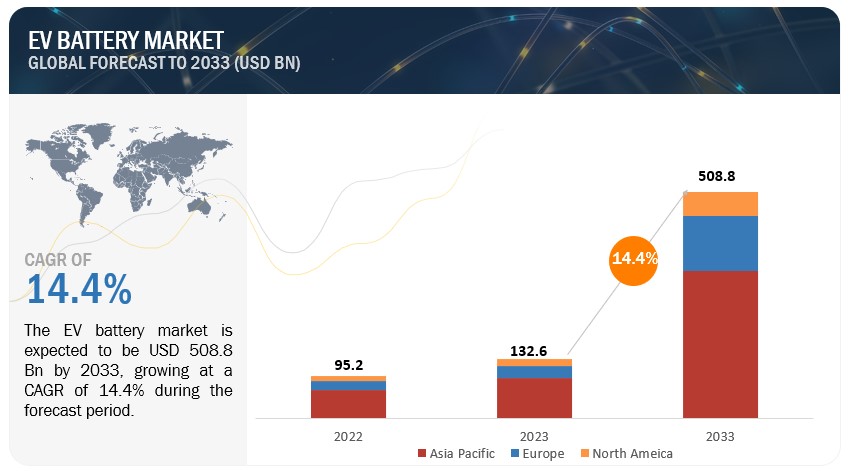
To know about the assumptions considered for the study, Request for Free Sample Report

To know about the assumptions considered for the study, download the pdf brochure
Market Dynamics:
Driver: Improvements in battery technology
There have been substantial improvements made by several companies in EV battery technology to make EVs a viable alternative to conventional vehicles. The table below covers significant improvements/innovations achieved by organizations in the EV battery market. Ongoing developments in the field of EV batteries are targeted toward improving the range of EVs, with most major manufacturers of EV batteries innovating in battery design and chemistry to extend the range of EVs to eliminate the requirement of regular charging. Cathode chemistry in the battery plays a critical role in battery performance. Presently, in the automotive sector, three broad categories of cathode chemistries are widely used: lithium nickel manganese cobalt oxide (NMC), lithium nickel cobalt aluminum oxide (NCA), and lithium iron phosphate (LFP). Out of these, NMC and NCA cathodes are in huge demand as they offer high energy density owing to the higher nickel content in the cathode. Besides, since 2020, given high battery metal prices, LFP has become more attractive as it contains no cobalt or nickel. LFP relies on lithium carbonate rather than hydroxide, which is used for nickel-rich chemistries. The cost advantages of LFP in a high commodity price market are a reason for the resurgence. Cell-to-pack (CTP) technology, which eliminates the need for modules to house cells in the battery pack, is increasingly adopted in many EV models. CTP also reduces the dead weight in the pack and improves the energy density of LFP batteries. The development of solid-state batteries is one of the most promising advancements in EV battery technology. These batteries use solid electrolytes rather than liquid or gel-based electrolytes, making them safer, more efficient, and longer lasting. Solid-state batteries also have a higher energy density than traditional batteries, which means they can store more energy in the same amount of space. Toyota and BMW are investing extensively in solid-state battery technology, and some companies, such as QuantumScape and Solid Power, are already making progress in this field.
Restraint: Development in hydrogen and ethanol vehicles
Hydrogen vehicles use fuel cells that generate electricity through a chemical reaction between hydrogen and oxygen, emitting only water and heat as by-products. They do not rely on traditional batteries like those in EVs. However, they might impact the EV battery market indirectly by competing for investment and infrastructural development in the clean transportation segment. If hydrogen vehicles gain widespread adoption, it might divert some investment away from EV batteries and charging infrastructure. Ethanol can be used in flex-fuel vehicles that also run on gasoline. These vehicles often use smaller batteries for starting and auxiliary functions, similar to hybrid cars. Therefore, their impact on the market for large battery packs will be minor. Similar to hydrogen vehicles, widespread adoption of ethanol-powered vehicles could slow the growth of the market by offering an alternative solution. However, the environmental impact of ethanol production varies and might not align with all sustainability goals, limiting its potential long-term impact.
Opportunity: Development in solid-state batteries
Solid-state batteries are a promising technology for electric vehicles as they have the ability to overcome various limitations of ordinary lithium-ion batteries. Many corporations and research organizations across the world are working on solid-state battery technologies. They are working to improve material design, manufacturing techniques, and scalability in order to make these batteries commercially viable. Furthermore, automakers, battery manufacturers, and technology firms are working together on research and development activities to speed the advancement and acceptance of solid-state batteries for EVs. A solid-state battery, which stores more energy with fewer components, can cut an electric car battery's already low carbon footprint by 24%. The study contrasts an NMC-811 solid-state battery, one of the most promising chemistries under development, with current lithium-ion technology. Solid state technology replaces liquid electrolytes with solid ceramic materials to transport electric current, making batteries lighter, faster to charge, and eventually cheaper. Solid-state batteries are expected to be used in EVs in the second half of the decade, according to battery manufacturers.
Challenge: High initial investments and high cost of electricity
EV battery manufacturing is capital-intensive and needs a high initial investment. Setting up a facility to produce batteries at scale, often referred to as "gigafactories," requires massive investments in land, buildings, specialized equipment, and technology. These facilities involve intricate processes and automation, necessitating high-precision machinery and advanced control systems. Apart from the initial investment, the cost of electricity is a challenge in some countries such as Italy, the UK, and Ireland where the cost of electricity is high and is constantly rising. This factor can impact the EV battery market negatively.
Market Ecosystem
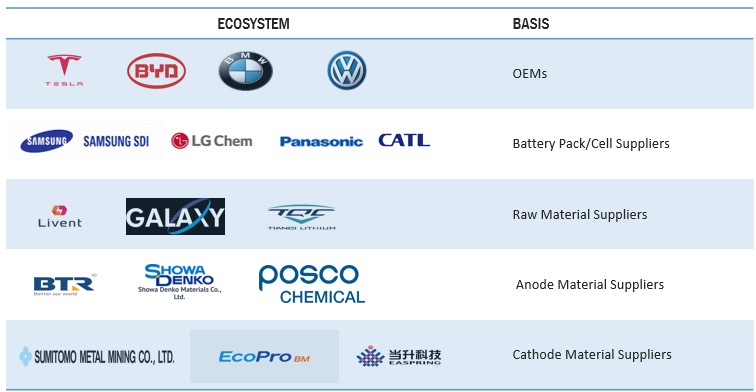
Lithium-Ion battery holds the largest market during the forecast period.
In the EV battery market, lithium-ion batteries have the largest market share. Several decades have passed since the development and refinement of lithium-ion battery technology. It is a mature technology with considerable research that has resulted in excellent levels of reliability and safety, making it a popular choice for EV producers. Continuous research and development activities aim to improve lithium-ion battery technology. In the market, incremental advancements in energy density, charging speed, lifetime, and safety features have solidified its supremacy. Additionally, Their decreasing cost is a major factor driving their demand. In June 2023, Toyota announced that it aims to launch next-generation lithium-ion batteries in 2026, offering longer ranges and quicker charging. Vehicles such as the Hyundai IONIQ 6, Nissan Ariva, Genesis GV60, Cadlillac Lyriq Toyota Bz4x, and Chevrolet Silverado EV are popular EVs with lithium-ion batteries launched in 2023. lithium-ion battery is making EVs more affordable and practical for consumers. Also, the expansion of charging infrastructure supports the growth of EVs. As more charging stations become available, consumers are more inclined to switch to EVs, further driving the demand for lithium-ion batteries.
Laser Bonding is the most prominent method in the EV battery markets during the forecast period.
The laser bonding segment is expected to lead the EV battery market during the forecast period. The laser bonding method is mostly preferred due to its non-contact process that enables the welding of dissimilar materials with high precision. It is used to bond the metal components of battery enclosures together. This can create a strong and leak-proof seal that protects the battery cells from the environment. Its benefits, such as improved electric conductivity, enhanced welding quality, and the ability to weld dissimilar metals, make the laser bonding method suitable for EV batteries. The upcoming new Chevrolet Silverado EV is a fully electric pickup truck that is powered by a large battery pack. The battery pack is bonded together using laser welding, which helps to create a strong and reliable bond that is resistant to corrosion. Laser bonding involves a metal ribbon attached to the surface to be welded by irradiating with a laser. The laser causes the ribbon to partially melt, and the ribbon metal gets mixed with the surface metal, thus creating a welded joint/bond. The acceptable temperature in a lithium-ion battery is between 20 ºC and 60 ºC (68 ºF and 140 ºF). Any temperature exceeding that range could lead to degradation in performance and cause thermal runaway. In laser bonding, the heat generated is much lower, which is also an added advantage. As the demand for EVs continues to grow, the demand for laser bonding is also expected to increase. This is due to the many benefits that laser bonding offers, such as improved performance, reduced production time, and increased flexibility.
Asia Pacific is the largest market for EV batteries during the forecast period.
The Asia Pacific EV battery market is led by China, Japan, and South Korea. China is the largest EV battery producer and user globally, and it is dominating the EV market in the region. The government has taken steps, including subsidies for EV buyers, compulsory laws for manufacturers to produce EVs against a particular number of vehicles manufactured, support for installing EV charging points across major cities, and regulations against excessive polluting vehicles. Japan and South Korea have also been growing their markets. Their governments have supported the growth in demand for EVs by installing EV charging stations, setting emission norms, and setting deadlines for shifting to full or hybrid EVs from ICE vehicles. India has undertaken policies to increase EV demand in the market. The new vehicle scrappage policy allows old vehicles to be scrapped for adopting low-emission vehicles. Other upcoming policies are expected to help the country become the fastest-growing market for EVs in the region in the coming years, which will also drive the demand for EV batteries. Asia Pacific is home not only to top market players, such as LG Chem, Panasonic, Samsung, and CATL but also to many OEMs that are dominating the global EV market. Japan also plays a vital role in battery technology in the Asia Pacific. With advancements in technologies such as BEVs and PHEVs, the Japanese market is expected to grow. In August 2023, China's BYD Co Ltd and South Korea's KG Mobility Co Ltd were in talks to jointly build an EV battery plant in South Korea. These developments are expected to boost the market in the Asia Pacific region.
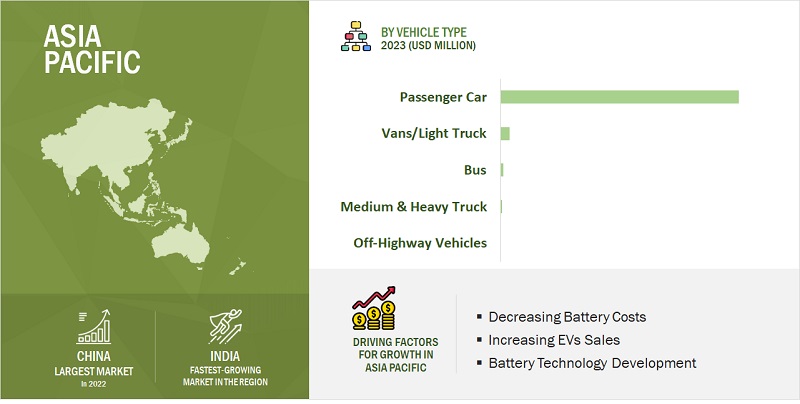
Key Market Players
The EV battery market is dominated by established players such as CATL (China), LG Energy Solution Ltd. (South Korea), BYD Company Ltd. (China), Panasonic Holdings Corporation (Japan), SK Innovation Co., Ltd. (South Korea) and others. These companies manufacture batteries and develop new technologies. These companies have set up R&D facilities and offer best-in-class products to their customers.
Get online access to the report on the World's First Market Intelligence Cloud
- Easy to Download Historical Data & Forecast Numbers
- Company Analysis Dashboard for high growth potential opportunities
- Research Analyst Access for customization & queries
- Competitor Analysis with Interactive dashboard
- Latest News, Updates & Trend analysis
Request Sample Scope of the Report
Get online access to the report on the World's First Market Intelligence Cloud
- Easy to Download Historical Data & Forecast Numbers
- Company Analysis Dashboard for high growth potential opportunities
- Research Analyst Access for customization & queries
- Competitor Analysis with Interactive dashboard
- Latest News, Updates & Trend analysis
|
Report Metric |
Details |
|
Market size available for years |
2019–2033 |
|
Base year considered |
2022 |
|
Forecast period |
2023-2033 |
|
Forecast units |
Volume (Thousand Units) and Value (USD Mn) |
|
Segments Covered |
Battery type, Propulsion, Battery Form, Vehicle type, material type, Battery Capacity, Method, Li-ion battery component and Region |
|
Geographies covered |
Asia Pacific, Europe, and North America |
|
Companies Covered |
CATL (China), LG Energy Solution Ltd. (South Korea), BYD Company Ltd. (China), Panasonic Holdings Corporation (Japan), and SK Innovation Co., Ltd. (South Korea) |
This research report categorizes the EV battery market based on Battery type, Propulsion, Battery Form, Vehicle type, material type, Battery Capacity, Method, Li-ion battery component and Region.
Based on Battery Type:
- Lead-Acid
- Lithium-Ion
- Solid-State
- Nickel-Metal Hydride
- Sodium-Ion
- Others
Based on Propulsion:
- BEV
- PHEV
- FCEV
- HEV
Based on Battery Form:
- Prismatic
- Pouch
- Cylindrical
Based on Vehicle Type:
- Passenger Cars
- Vans/Light Trucks
- Medium & Heavy Trucks
- Buses
- Off-Highway Vehicles
Based on Material Type:
- Cobalt
- Lithium
- Natural Graphite
- Manganese
- Iron
- Phosphate
- Nickel
- Others
Based on Battery Capacity:
- <50 kWh
- 50–110 kW
- 111–200 kWh
- 201–300 kWh
- >300 kWh
Based on Li-Ion Battery Component:
- Positive Electrode
- Negative Electrode
- Electrolyte
- Separator
Based on the region:
-
Asia Pacific
- China
- India
- Japan
- Thailand
- South Korea
-
North America
- Canada
- US
-
Europe
- France
- Germany
- Spain
- Italy
- The UK
- Sweden
- Norway
- Denmark
Recent Developments
- In November 2023, BYD and KG Mobility signed a battery pack factory agreement to jointly develop next-generation hybrid systems.
- In October 2023, Samsung SDI clinched a supply deal for electric vehicle batteries with Hyundai Motor Company for the first time. Samsung SDI said the company will supply prismatic batteries for Hyundai Motor’s electric vehicles, targeting the European market for seven years from 2026 through 2032.
- In October 2023, LG Energy Solution and Toyota Motor North America, Inc. (Toyota) announced that they have signed a supply agreement for lithium-ion battery modules to be used in Toyota battery electric vehicles (BEVs) that will be assembled in the US. Under the contract, LG Energy Solution will supply automotive battery modules at an annual capacity of 20 GWh starting from 2025.
- In July 2023, Gotion High-tech and BASF signed an MoU, aiming to combine their technological advantages to strengthen cooperation in the field of material science further and jointly promote the innovation and technological progress of power battery materials.
- In June 2023, Vehicle Energy Japan Inc. announced that its lithium-ion battery module has been adopted in the Compact Crossover “JUKE” Hybrid, which has been launched in Europe by Nissan Motor Co., Ltd.
Frequently Asked Questions (FAQ):
What is the current size of the EV battery market by value?
The current size of the EV battery market is estimated at USD 132.6 Billion in 2023.
Who are the winners in the EV battery market?
The EV battery market is dominated by established players such as CATL (China), LG Energy Solution Ltd. (South Korea), BYD Company Ltd. (China), Panasonic Holdings Corporation (Japan), SK Innovation Co., Ltd. (South Korea) and others. These companies manufacture batteries and develop new technologies. These companies have set up R&D facilities and offer best-in-class products to their customers.
Which region will have the fastest-growing market for EV battery market?
Europe will be the fastest-growing EV battery market region as Europe is aiming for self-sufficiency in battery production to reduce reliance on Asian imports and address supply chain vulnerabilities. This involves building numerous gigafactories across the continent, creating jobs, strengthening the economy, and shortening supply chains.
What are the new market trends impacting the growth of the EV battery market?
The key trends impacting the growth of the EV battery market are increased energy density, reduced cost per kilowatt-hour, transition to solid-state batteries, and diversification of battery chemistries.
What are different countries covered in the Asia-Oceania region for the EV battery market?
The countries covered in report for the EV battery market are China, Japan, India, South Korea, and Thailand. .
To speak to our analyst for a discussion on the above findings, click Speak to Analyst
This research study involved the extensive use of secondary sources, such as company annual reports/presentations, industry association publications, automotive magazine articles, directories, technical handbooks, the World Economic Outlook, trade websites, technical articles, and databases, to identify and collect information on the EV battery market. In-depth interviews were conducted with various primary respondents, including key industry participants, subject-matter experts (SMEs), C-level executives of key market players (EV battery and EV battery component manufacturers), and industry consultants, among other experts, to obtain and verify critical qualitative and quantitative information and assess market prospects.
Secondary Research
In the secondary research process, various secondary sources were used to identify and collect information for this study. The secondary sources include annual reports, press releases, and investor presentations of companies; whitepapers, certified publications; articles from recognized authors, directories, and databases; and articles from recognized associations and government publishing sources. Secondary research has been used to obtain key information about the industry’s value chain, the overall pool of key players, market classification and segmentation according to industry trends to the bottom-most level, regional markets, and key developments from the market- and technology-oriented perspectives.
Primary Research
Extensive primary research was conducted after acquiring an understanding of the global EV battery market scenarios through secondary research. Several primary interviews were conducted with market experts from both the demand (country-level government associations, trade associations, institutes, R&D centers, and OEMs/vehicle manufacturers) and supply (EV battery manufacturers, EV component manufacturers, and raw material suppliers) sides across three major regions, namely, North America, Europe, and Asia Pacific. 23% of the experts involved in primary interviews were from the demand side, and 77% were from the supply side of the industry. Primary data was collected through questionnaires, emails, and telephonic interviews. Several primary interviews were conducted from various departments within organizations, such as sales, operations, administration, and so on, to provide a holistic viewpoint in the report.
After interacting with industry participants, some brief sessions were conducted with experienced independent consultants to reinforce the findings from the primary interviews. This, along with the in-house subject matter experts’ opinions, led to the findings delineated in the rest of this report.
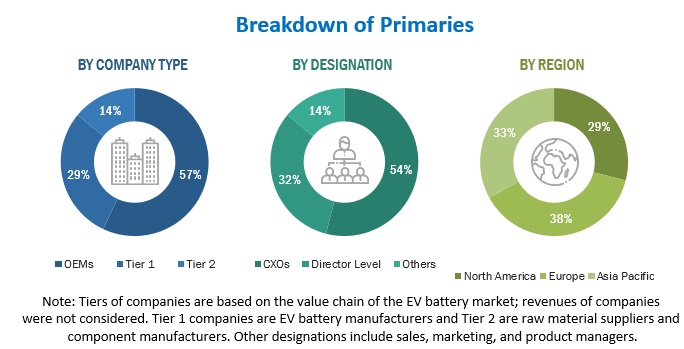
To know about the assumptions considered for the study, download the pdf brochure
Market Size Estimation
The bottom-up approach was used to estimate and validate the total market size. This method was also used extensively to estimate the size of various subsegments in the market. The research methodology used to estimate the market size includes the following:
- The key players in the industry and markets have been identified through extensive secondary research
- The industry’s supply chain and market size, in terms of volume, have been determined through primary and secondary research processes.
- All percentage shares, splits, and breakdowns have been determined using secondary sources and verified through primary sources.
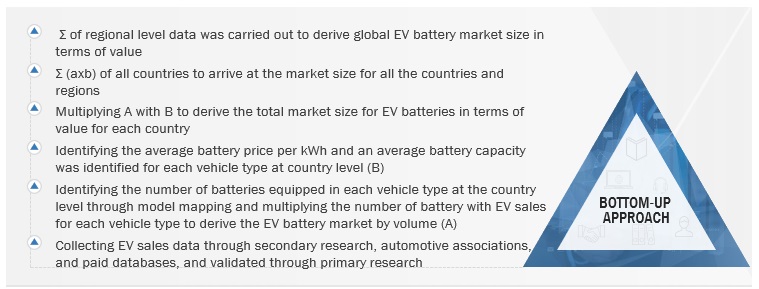
To know about the assumptions considered for the study, Request for Free Sample Report
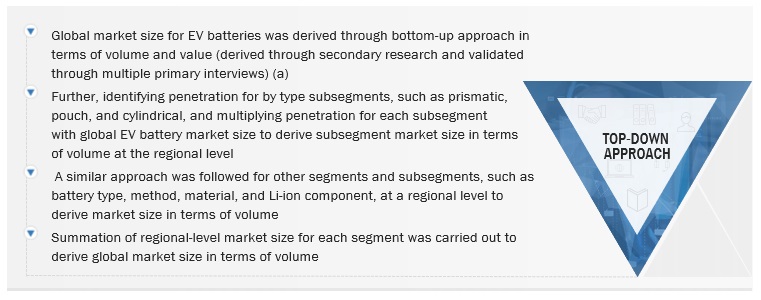
Data Triangulation
After arriving at the overall market size—using the market size estimation processes as explained above—the market was split into several segments and subsegments. To complete the overall market engineering process and arrive at the exact statistics of each market segment and subsegment, data triangulation and market breakdown procedures were employed, wherever applicable. The data was triangulated by studying various factors and trends from both the demand and supply sides.
Market Definition
According to the Batteries Directive 2006/66/EC, batteries are defined as any source of electrical energy generated by direct conversion of chemical energy and consisting of one or more primary battery cells (non-rechargeable) or one or more secondary battery cells (rechargeable). An EV battery is a rechargeable battery used to power BEVs), PHEVs, and HEVs. An EV battery usually comprises numerous small, individual cells arranged in series or parallel to achieve the desired voltage and capacity.
List of Key Stakeholders
- Automotive OEMs
- Battery-related Service Providers
- End Users
- EV Battery Casing Manufacturers
- EV Component Manufacturers
- EV Battery Manufacturing Organizations
- EV Battery Cell Manufacturing Organizations
- EV Battery Pack Manufacturing Organizations
- EV Battery Raw Material Miners and Suppliers
- EV Battery Raw Material Refinery Companies
- EV Infrastructure Component Manufacturers
- EV Infrastructure Developers
- Government Bodies (who directly and indirectly provide incentives, aid, and orders to EV manufacturers)
- Manufacturers of Electric Vehicles (EVs)
- Regulatory Bodies
- Traders and Distributors of Electric Vehicles
- Traders, Distributors, and Suppliers of EV Battery Components
Report Objectives
- To define, describe, and project the electric vehicle (EV) battery market in terms of volume (thousand units) and value (USD million)
- To analyze and forecast the market based on battery type, lithium-ion battery component, propulsion, vehicle type, method, battery capacity, material type, battery form, and region
- To analyze and forecast the market, in terms of value, based on lithium-ion battery component (positive electrode, negative electrode, electrolyte, and separator)
- To analyze and forecast the market, in terms of volume, based on propulsion [battery electric vehicle (BEV), plug-hybrid electric vehicle (PHEV), and fuel cell electric vehicle (FCEV) and hybrid electric vehicle (HEV)].
- To analyze and forecast the market in terms of volume and value based on vehicle type (passenger cars, vans/light trucks, medium & heavy trucks, buses, and off-highway vehicles)
- To analyze and forecast the market in terms of volume and value based on battery capacity (<50 kWh, 50–110 kWh, 111–200 kWh, 201–300 kWh, and >300 kWh)
- To analyze and forecast the market in terms of value based on material type (cobalt, lithium, natural graphite, manganese, iron, phosphate, nickel, and others)
- To analyze and forecast the market in terms of volume based on battery form (prismatic, pouch, and cylindrical)
- To analyze and forecast market in terms of volume based on battery type (lead-acid, lithium-ion, solid-state, nickel-metal hydride, sodium-ion, and others)
- To analyze and forecast the market in terms of volume based on method (wire bonding, laser bonding, and ultrasonic metal welding)
- To forecast the size of various segments of the EV battery market based on three regions—North America, Europe, and Asia Pacific, along with major countries in each region
- To provide detailed information regarding major factors, such as drivers, restraints, opportunities, and challenges influencing the growth of the market
Available Customizations
With the given market data, MarketsandMarkets offers customizations in accordance with company-specific needs.
- Additional company profile
- EV battery market, by propulsion type at the country level
- EV battery market, by propulsion type at the vehicle type level


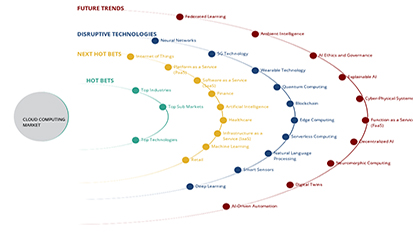

 Generating Response ...
Generating Response ...







Growth opportunities and latent adjacency in EV Battery Market
Which factors are majorly influencing the global growth of EV Battery Market?
We need details on the passenger cars segment for this market in Asia & Africa